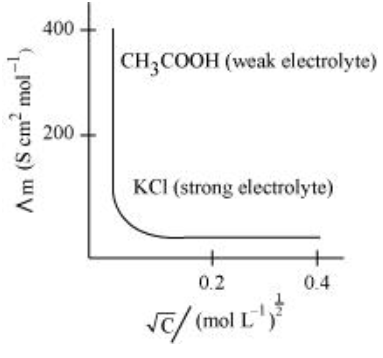Define conductivity and molar conductivity for the solution of an electrolyte. Discuss their variation with concentration.
Conductivity of a solution is defined as the conductance of a solution of 1 cm in length and area of cross-section 1 sq. cm. The inverse of resistivity is called conductivity or specific conductance. It is represented by the symbolκ. If ρ is resistivity, then we can write:
$\kappa=\frac{1}{\rho}$
The conductivity of a solution at any given concentration is the conductance (G) of one unit volume of solution kept between two platinum electrodes with the unit area of cross-section and at a distance of unit length.
i.e., $G=\kappa \frac{a}{l}=\kappa \cdot 1=\kappa$
(Since a = 1, l = 1)
Conductivity always decreases with a decrease in concentration, both for weak and strong electrolytes. This is because the number of ions per unit volume that carry the current in a solution decreases with a decrease in concentration.
Molar conductivity:
Molar conductivity of a solution at a given concentration is the conductance of volume V of a solution containing 1 mole of the electrolyte kept between two electrodes with the area of cross-section A and distance of unit length.
$\Lambda_{m}=\kappa \frac{A}{l}$
Now, l = 1 and A = V (volume containing 1 mole of the electrolyte).
$\therefore \Lambda_{m}=\kappa \mathrm{V}$
Molar conductivity increases with a decrease in concentration. This is because the total volume V of the solution containing one mole of the electrolyte increases on dilution.
The variation of $\Lambda_{m}$ with $\sqrt{\mathrm{c}}$ for strong and weak electrolytes is shown in the following plot:

Click here to get exam-ready with eSaral
For making your preparation journey smoother of JEE, NEET and Class 8 to 10, grab our app now.
